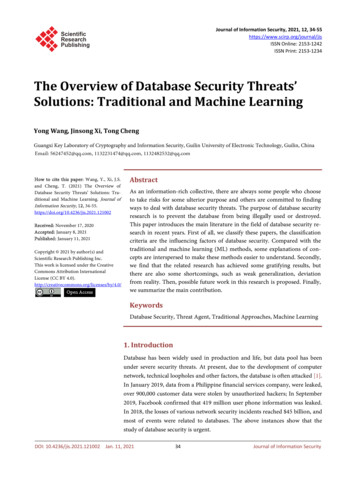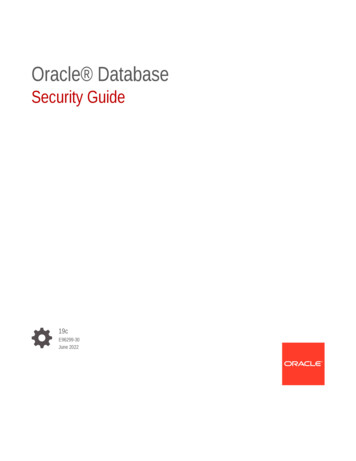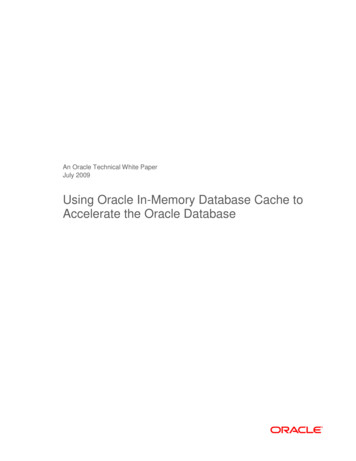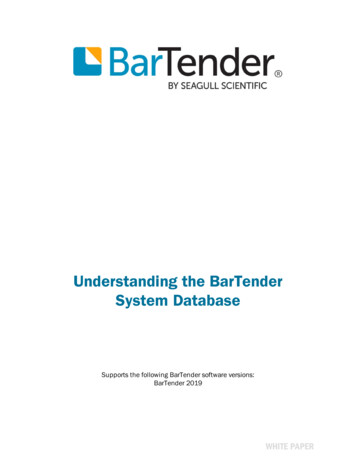
Transcription
Journal of Information Security, 2021, 12, 34-55https://www.scirp.org/journal/jisISSN Online: 2153-1242ISSN Print: 2153-1234The Overview of Database Security Threats’Solutions: Traditional and Machine LearningYong Wang, Jinsong Xi, Tong ChengGuangxi Key Laboratory of Cryptography and Information Security, Guilin University of Electronic Technology, Guilin, ChinaHow to cite this paper: Wang, Y., Xi, J.S.and Cheng, T. (2021) The Overview ofDatabase Security Threats’ Solutions: Traditional and Machine Learning. Journal ofInformation Security, 12, ved: November 17, 2020Accepted: January 8, 2021Published: January 11, 2021Copyright 2021 by author(s) andScientific Research Publishing Inc.This work is licensed under the CreativeCommons Attribution InternationalLicense (CC BY en AccessAbstractAs an information-rich collective, there are always some people who chooseto take risks for some ulterior purpose and others are committed to findingways to deal with database security threats. The purpose of database securityresearch is to prevent the database from being illegally used or destroyed.This paper introduces the main literature in the field of database security research in recent years. First of all, we classify these papers, the classificationcriteria are the influencing factors of database security. Compared with thetraditional and machine learning (ML) methods, some explanations of concepts are interspersed to make these methods easier to understand. Secondly,we find that the related research has achieved some gratifying results, butthere are also some shortcomings, such as weak generalization, deviationfrom reality. Then, possible future work in this research is proposed. Finally,we summarize the main contribution.KeywordsDatabase Security, Threat Agent, Traditional Approaches, Machine Learning1. IntroductionDatabase has been widely used in production and life, but data pool has beenunder severe security threats. At present, due to the development of computernetwork, technical loopholes and other factors, the database is often attacked [1].In January 2019, data from a Philippine financial services company, were leaked,over 900,000 customer data were stolen by unauthorized hackers; In September2019, Facebook confirmed that 419 million user phone information was leaked.In 2018, the losses of various network security incidents reached 45 billion, andmost of events were related to databases. The above instances show that thestudy of database security is urgent.DOI: 10.4236/jis.2021.121002Jan. 11, 202134Journal of Information Security
Y. Wang et al.With the increasing complexity of data and database functions, the change ofattackers’ attacking methods and the improvement of technology, traditionalmethods cannot meet the reality. Machine learning (ML) can transform sequential scanning into calculation model and DBA (Database Administrator) experience into prediction model, which makes the intrusion detection more intelligent and dynamic to adapt to the rapid variety of workload changes [2], and nowcomputing power can satisfy machine learning. Therefore, there are more andmore articles applying machine learning in database security threat response, butfew people sort out these coping methods, which reflects the advantages of machine learning over traditional methods in dealing with some threats types.This paper first obtains the source of database security threats, as shown inFigure 1. Then we carefully sort out and review the papers dealing with thesethreats, and find that machine learning has its advantages. Finally, we point outthe shortcomings of relevant research and possible research directions.The organization of this paper proceeds as follows. Section 2 summarizes datasecurity issues and solutions. Sections 3, 4, 5 and 6 elaborate database securitythreats’ solutions from four aspects: ineffectively data protection, user exception,vulnerability of defense system, and external attacks. Section 7 carries out research prospects and briefly sums up the full text.2. Database Security Issues and SolutionsWith the development of IT, database security risks are manifold [3]. We combthe research on database security, and find these factors closely related to database security: data, role, defense system, external factors. Therefore, we mark offfour main threat sources: ineffective data protection, abnormal users, fragile defense system and external attacks. Data can be further divided into three categories: data tampering, data exposure, data being monitored or collected. User exception is subdivided into: illegal behavior, unauthorized access, weak securityFigure 1. Sources of database security threats.DOI: 10.4236/jis.2021.12100235Journal of Information Security
Y. Wang et al.awareness. Weak defense system can also be divided by vulnerability, inaccurateidentification. The external attacks are the main source of database securitythreats and they cause the most serious damage. Further, there are many secondary categories, including spam, malicious traffic, SQL injection, illegal access,malware, DDoS attacks, bypass and physical attacks. For the above-mentionedvarious security threats and their import, researchers use a series of methods todeal with these threats, as shown in Table 1. In the following four sections, theTable 1. Solutions and damage to database security threats.First level threats Second level threatsData noteffectivelyprotectedUser exceptionVulnerability ofDefense systemExternal attackDOI: 10.4236/jis.2021.121002DamageSolutionsData tamperingData distortionor invalidTamper detection,User authentication,data encryption,Tamper proof materialData exposureIllegal useUser’ dataUser authentication,data encryption,Audit, Constructmachine learning modelData monitoredor collectedPrivacydisclosureEstablishment of specialsystem, data encryptionIllegal actBreak the rolecode of conductIntrusion detection,Establishment ofspecial system, Userbehavior analysisUnauthorizedaccessIllegal processingof dataAccess controlWeak safetyawarenessCreate a breakthroughfor attackersEmpirical researchBugUsed to destroythe databaseSafety assessment,Empirical frameworkInaccurateidentificationReject normal usersand accept illegal usersUser authenticationSpamOccupy a lot of storagespace and commit fraudAccess controlMalicious trafficServer works abnormallyAudit,Intrusion detectionSQL injectionEmbedded trojan horseand illegal right raisingAccess control, Accesscontrol, User behavioranalysis, System riskpredictionIllegal accessBreak systemauthenticationmechanism andobtain others dataUser authentication,Establishment ofspecial system,Intrusion detectionMalicioussoftwareIllegal access touser secret dataData encryption,Malware detection,Intrusion detectionDDoS attackSystem functionsnot availableIntrusion detection,Access controlBypass andphysical attackHardware Damageand less preventableIntrusion detection,Tamper proof material36Journal of Information Security
Y. Wang et al.above-mentioned four database security threats sources are expanded successively, various threats attack principles and response methods are analyzed indetail.3. Data Ineffectively Protected Problems and SolutionsData is the most watched factor among database security-related factors, sincedatabases store large amounts of data. The data in the database is faced with serious threat. In January 2018, data from Indian citizenship database was leaked,including private information such as fingerprints and general personal information such as birthday. The main threat to data factor is ineffective data protection, such as data exposure, data tampering, data being monitored or collected. This section will focus on these threats.3.1. Data Exposure Problems and SolutionsData exposure means that data in a database is stored in clear text, and an attacker can easily get the data when he breaks through the defense system. In2012, Rambler’s database in Russia was leaked, and even more alarmingly, nearly100 million user passwords were leaked and stored in plain text. Unfortunately,in order to the efficiency of access, much data is still stored in clear text recently.Most researchers focus on data encryption. Ni et al. [4] proposed to encryptsensitive data and the database, this method is only for specific systems and haspoor scalability. Wang et al. [5] designed a general database encryption and decryption engine system, the system encrypted data on the application side, andutilized different user IDs to identify different transmission commands, and finally exploited the user’s private key for encryption storage, but they should clarify the generation and distribution of keys. Hence, Huang et al. [6] adopted aweighted encryption scheme and related access control policies, however, theencryption and decryption process might be cumbersome excessively, leading tonot so satisfactory application efficiency. Zhang et al. [7] firstly classified the users of web server: ordinary users, high-level users, and then encrypted the data ofthe high-level users. The method ensured the data security of high-level users,but might ignore ordinary users. Mei et al. [8] improved the AES algorithm andapplied the encryption algorithm to the database management system, theyconverted the user name, password, database and user’s activity with AES, thismethod had a wide range of applications and high reliability, but only processedbinary files. Dandekar et al. [9] combined SHA-256 with ASCII control replacement technology to hide database data. They used the SHA-256 algorithm tomake SOH replace binary information and generated hash values, and thencompared the hash values with the encoded information, the efficiency of thisapproach was not so good. Andrey et al. [10] also embedded special code elements and representative data into a symmetric cryptographic algorithm, theyreplaced plain text elements with elements of the sequence associated with thekey and then restored plain text through the key, the method effectively simpliDOI: 10.4236/jis.2021.12100237Journal of Information Security
Y. Wang et al.fied the encryption operation, but had lower data security. Awais et al. [11] deployed parallel query execution techniques and AES on different data records,they used hash functions on metadata and multithreading on.NET applications,and then exploited AES encryption before inserting data into the data table.However, there would be conflicts when multiple technologies are used together.Uma et al. [12] utilized AES encryption and MD5 code conversion in the Medical Records Security System database. AES divides 128-bit medical data into fourbasic blocks for processing, while MD5 code divides any medical data into512-bit data blocks and generates a fixed 128-bit length result, but the efficiencyof this method is not high. He et al. [13] exploited quantum cipher to encryptdatabase data, they combined key dilution and auxiliary parameters, only a fewquanta were sent in the quantum channel to generate the initial key, then the initial key was diluted by bitwise addition to several consecutive bits. The strategy’s performance was high, but the quantum cipher was not yet mature enough.Fortunately, machine learning models were applied to data encryption. Shumeet[14] utilized DNN (Deep Neural Network) to hide image data from the databasein the image. DNN is a neural network with a multilayer hidden layer. The basicstructure is shown in Figure 2 below. He exploited a large number of bits toembed RGB pixels of panchromatic images into another similar image of thesame size, and then hid the decoding results and the appearance of the host image through a compression network of deep nerves. Experiments showed thatthe hiding effect was fine, but the hiding image required a lot of extra storagespace. After an attacker detected a large number of hidden images, it was easy torecognize the image contents.There are other ways to solve database data exposure issues. Wang et al. [15]firstly designed a signature scheme that could specify a verifier by using the authentication method. After signing the root node with this scheme, users needserver participation to verify data using MHT tree. The experimental resultsshowed that the verification speed was fast and the database data could be protected effectively, but the operability of the method was not strong. Jovan et al.Figure 2. Basic structure of deep neural network.DOI: 10.4236/jis.2021.12100238Journal of Information Security
Y. Wang et al.[16] brought block chain technology to database security, their system sent different coded data blocks through separate channels, and exploited block chainsto store encoding matrices for distributed storage systems. However, in somescenarios, each channel needs to be highly uncorrelated to avoid data interaction, so this method was limited. Auditing is also used by researchers, Vitthal etal. [17] proposed data auditing on the public cloud by third-party auditors. Auditors could read the data, but costs might be high unduly. Modeling methodologies are also considered. Minh et al. [18] attempted to build a common modelfor database data security using cloud services. They performed a feasibilityanalysis of information to create risk models. In machine learning, Boudheb etal. [19] exploited genetic algorithms and Naive Bayes to protect medical data.Genetic algorithm was a computational model that simulated the natural selection and genetic mechanism of Darwin’s biological evolution. On the premise ofindependent and identical distribution of objects, Naive Bayesian obtains theposterior probability of objects from the prior probability of objects, and thenuses the maximum posterior probability to determine the category of objects[20]. The specific calculation steps are as following: Figure 3. There are manysources of medical data and complex storage. The selection of safety featuresplayed a decisive role in the training model, the paper utilized the most representative safety features (patient identification, birthday, blood type, etc.).3.2. Data Tampering Problems and SolutionsData tampering means that the data in the database has been illegally altered, thesituation causes the original data to be lost, replaced, or added or subtracted. InJanuary 2010, the website of an educational examination center was invaded,and somebody logged into the database, he added a record of someone’s exampassing information, such behavior seriously violated the fairness of the examination.Some research is intended to prevent data tampering. Piggin et al. [21] exploited honeypot technology in common physical components of a databasesystem to attract attackers to modify fake data, and then to protect truly valuabledata, but there was a risk that the honeypot could be used to attack by attackers.Elena et al. [22] implemented data entry through spin current, they made use ofFigure 3. Steps of simple Bayesian calculation.DOI: 10.4236/jis.2021.12100239Journal of Information Security
Y. Wang et al.the high variability that affected the resistance of magnetic tunnel junction devices and the special configuration of read operation reference units to make data physically non-cloning, the effectiveness of this method was proved in theory,but lack of practical verification. The development of machine learning alsobrings an opportunity to solve the issue. Some researchers have focused on ECG(electrocardiogram) data, which is physically non-cloning and can effectivelycombat data tampering. Yin et al. [23] learned and extracted different featuresbefore using the neural network training data to minimize overlap in the distribution of cosine/hamming distances between individual and inter-individual,but that needed large amount of calculation. Kiran [24] introduced a minimumabsolute contraction selection operator to identify the most appropriate ECGfeatures. This method effectively avoided random, correlated, and over-fittingfeatures, and reduced the feature space, and improved the prediction speed, butthe detection accuracy was reduced slightly. He also proposed an effective ECGfeature extraction method [25], which extracted six optimal segments based onpriority and normalizes positions, but there might be over fitting.Some research focuses on the processing of data tampering when it has happened. Li et al. [26] hoped that the normal data query service would continueafter the data was partially polluted. They utilized the data query service rules todetermine whether they decided to return the user’s partially legitimate data collection. This method improved the usability of the database, but could not determine the location of the data pollution. Yin et al. [27] designed a detectionmechanism for database tampering, they exploited two signatures both horizontally and vertically to ensure that the data table could be detected by signatureafter tampering with the data sheet. However, the system cost a lot and the operation was cumbersome. Xian et al. [28] took a simpler approach. After the serverresponded to a query request, the servicer sent the verification value, the mask ofthe verification tree, and the signature of the mask and the number of root nodesof the verification tree to the query party to verify whether the data had beentampered with. This method effectively decreased the amount of computation,but reduced the safety. In machine learning method, Lai et al. [29] exploitedK-means clustering algorithm. K-means’ workflow is: randomly selecting kpoints as the initial centroid, and then assigning each point in the dataset to acluster. In order to detect the web page data which had been tampered with, theygrabbed information from the first page of some websites and established detection rules by classifying the data to determine whether the web page had beenmisrepresented. However, this method needed to adjust the detector, which required rich experience in dealing with hackers, and wrong adjustment wouldgreatly reduce the recognition effect.3.3. Data Monitored or Collection Problems and SolutionsData is eavesdropped or collected by an attacker during transmission, and thenthey analyze the information about the target. Recently, social software has beenexposed to monitor user chat records, the conduct seriously violates user privaDOI: 10.4236/jis.2021.12100240Journal of Information Security
Y. Wang et al.cy.Data encryption is the most common way to solve the problem. Kushko et al.[30] proposed a new method to protect network data transmission, they hid theinteraction between nodes in the network and utilized encryption, multicast andpacket retransmit for traffic interaction, the operation was too complicated.Andrey et al. [31] introduced the homologous encryption and logistic regressionmodel. Homologous encryption enabled people to perform certain forms of algebraic operations on cipher text and still encrypted it. The result of decryptionwas the same as that of plain text. They lessened the storage of encrypted databases by using an approximate homologous encryption method, and acceleratedgradients by using logistic regression models to speed up computations. However, logistic regression was prone to the phenomenon of under fitting. In additionto data encryption, Li et al. [32] exploited a remote method to invoke the serverto receive and parse network packets transmitted by the server-side proxy, andthen to filter the address information securely, and finally to invoke the JDBCdriver to connect to each database management system for data interaction andreturn the results, but the solution was costly to implement.4. User Exceptions Problem and SolutionsUser exceptions are the most difficult to guard against in database securitythreats. In March 2017, Tencent jointly with the Jingdong security team uncovered a case of self-theft. An insider in Jingdong stole more than 5 billion piecesof information. After that, they made profits by selling through various illegalways, such action caused huge economic and reputation losses in Jingdong. Researchers subdivide user anomaly threats into illegal behavior, unauthorizedaccess, and weak security awareness.4.1. Illegal Acts Problems and SolutionsIllegal behavior refers to the user’s behavior that violates the role positioning orbehavior rules in the database, such as unauthorized access to the database, users’ illegal operations in the database system, and so on.Researchers want to detect such behaviors. Chen et al. [33] utilized C and C#to achieve real-time tracking and analysis of database operation information,database and server status, but the efficiency should be improved. In order toimprove the processing speed, the machine learning model is introduced. Liu[34] exploited the naive Bayesian classification algorithm to build files for eachdatabase role, then trained the user behavior database, and finally classified thedatabase transaction through the user behavior database, but it lacked experimental support. Andrey et al. [35] utilized a K-means clustering algorithm toprocess text log information. They converted the text log information into clustering vectors, calculated outliers, and sorted the output anomalies to get theclusters to which the user behavior log information most likely belonged, but theprocessing accuracy needed to be improved, and this method could only applysingle structure text log.DOI: 10.4236/jis.2021.12100241Journal of Information Security
Y. Wang et al.4.2. Unauthorized Access Problem and SolutionsUnauthorized access refers to users illegally accessing data that does not conform to their privileges by means of delegation, etc. An average user can be anadministrator, or even a super administrator by privilege promotion, and thenhe can acquire other user data.Access control is a widely used solution. Xu et al. [36] gave the user a multilevel role name based on which to acquire internal roles before granting the userpermissions, but this method could not resist hidden channel access effectively.He et al. [37] utilized the security baseline to evaluate the database access control, and took measures to improve the control effect after quantifying the score,however, there was no specific method to improve the effect of access control.An et al. [38] exploited the history of multi-connection pool and different configurations to achieve strict and dynamic access control. Yang et al. [39] proposed a method to refine database access control through permission extension.They split the primary key in the permission table into corresponding storagestructure and saved permission information with built-in key values to achievemore refined access control, but the application scenarios were limited.4.3. Weak Safety Awareness Problem and SolutionsWeak security awareness means that database users create attack points that maybe exploited by attackers for the sake of saving trouble, such as setting weakpassword and not modifying the default password of database, the consciousnesscan improve security through educational means. Therefore, there are a few related technological research papers. Yung et al. [40] investigated the impact ofsecurity awareness on bank security performance management and the use ofinformation technology through a questionnaire, and concluded that compliance had a significant impact on information security management performance and information technology capabilities.5. Vulnerability of Defense System Problem and SolutionsThe vulnerability of database defense system is reflected in two layers: the operating system layer and the database layer. The former refers to that the user’shost is easy to be controlled by hackers and then attacked, while the latter refersto the unclear division of storage authority and the incorrect configuration byDBA. There was fragility in SQL server, the default password of SA, the superadministrator, was empty. Attackers could log in to SQL server directly throughSA account without password. There are two reasons for the vulnerability of database defense system: firstly, there are defects in initial configuration, secondly,the system’s identification is not accurate.5.1. Bug Problems and SolutionsBug refers to the design defects of database defense system. In May 2011, hackersused the user of Oracle database to invade the database of Korea Convention andDOI: 10.4236/jis.2021.12100242Journal of Information Security
Y. Wang et al.Exhibition Center. The reason why the system was broken was that the DBSNMPuser used the default password.Most researchers adopt the strategy of defense in advance. Gao [41] designeda database security evaluation model for SQL server, Sybase and Oracle, the method could evaluate the overall security of the database. Kozlov et al. [42] utilizedfuzzy logic to evaluate the security of enterprise information management system. They expressed all possible threats of the system into a function, and eachvalue of the function represented a possible threat. An attack tree was constructed to deal with each threat. Zhang et al. [43] presented intelligent securityassessment for system software. They exploited crawlers to obtain natural language evaluation data, and then utilized various machine learning methods toobtain safety evaluation indicators to build a security assessment model, but themethod was not easy to implement.5.2. Inaccurate Identification Problems and SolutionsInaccurate identification means that the illegal users are wrongly identified asnormal users or normal users are identified as illegal users when the databaseconducts identification. As a good identification method, biometric identification method is fast, safe and rapid development, but biometrics verification alsoacts out some problems.Prabu et al. [44] exploited the effective linear binary pattern and scaled invariant Fourier transform to process and store the biometrics of hand type and irisinto database, and then utilized neural network and Bayesian network classifierto detect, due to mix the two biological features together, the recognition is inefficient. Musab et al. [45] exploited CNN (Convolutional Neural Network) toimprove the recognition effect of face recognition. CNN is a feed forward neuralnetwork with deep structure including convolution calculation. The basic structure is shown in Figure 4 below. The author improved CNN by adding standardoperation between input layer and output layer, the improvement could accelerate network standardization, but there was a problem of over-fitting in facerecognition. Aishwarya et al. [46] utilized aggregation and RF (Random Forest)to improve face recognition rate. RF introduces random attribute selection in thetraining process of decision tree [47]. They exploited local aggregation to storethe features of the detected face images, and then use RF to train and classifiedface images, this method consumed a lot of storage space. However, Csaba [48]Figure 4. Basic structure of convolutional neural network.DOI: 10.4236/jis.2021.12100243Journal of Information Security
Y. Wang et al.pointed out the inherent problems of biometrics: lacking relevant features, highspending, and privacy issues.6. External Attack Problems and SolutionsOvert attack refers to external attacker directly threatening database securitythrough some ways. The blackmail virus appeared in the first half of 2019, whichencrypted the important data in the user system. This virus had caused greatdamage to the social service infrastructure on a global scale. As the main threatto database security, external attacks can be roughly divided into seven categories: spam, malicious traffic, SQL injection, illegal access, malware, DDoS attacks, bypass and physical attacks.6.1. Spam Problems and SolutionsSpam refers to a large number of emails sent by attackers to users with phishing,advertisements, viruses, etc., junk mail will occupy a large amount of storagespace in the e-mail database, and users may suffer economic losses after clickingon such e-mails. The operation of the mail system will involve multiple databases and protocols, and the specific process is shown as Figure 5.Researchers use machine learning method to improve the ability of spam detection. He et al. [49] utilized language decision tree to improve the performanceof spam detection based on semantic features. Language decision tree classifiessamples with different linguistic attributes through tree structure. They extractedfeature information from spam information and decomposed junk mail intoseveral feature subsets in the light of the meaning of attributes. Then theyprocessed, classified and trained these feature subsets by using language decisiontree to get the spam classification model, however, they did not consider that themachine learning model was attacked.6.2. Malicious Traffic Problems and SolutionsMalevolent traffic refers to a large number of requests forged by external attackers through some tools to prevent normal users from accessing the database. InAugust 2019, snapex platform was attacked by malicious traffic saturation byhackers, which made the platform users temporarily unable to access, and someusers suffered economic losses because they were unable to trade virtual currency.There are many ways for researchers to deal with malicious traffic. Zhang etal. [50] exploited the method of security audit. They firstly captured the user’saccess operation data to the database, then submitted the data to the auditors foranalysis, and finally fed back the results. The method relied too much on theFigure 5. Workflow of mail system.DOI: 10.4236/jis.2021.12100244Journal of Information Security
Y. Wang et al.expertise of auditors and was inefficient to handle large-scale data situations. Yu[51] introduced CNN (convolutional neural network) for intrusion detection.He numerically processed the tra
above-mentioned four database security threats sources are expanded succes-sively, various threats attack principles and response methods are analyzed in detail. 3. Data Ineffectively Protected Problems and Solutions Data is the most watched factor among database security-related factors, since databases store large amounts of data.











